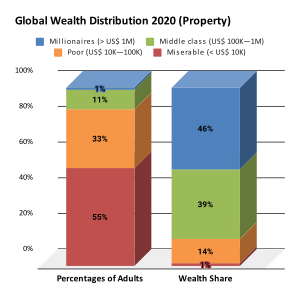
Back التفاوت الاقتصادي Arabic Beynəlxalq bərabərsizlik Azerbaijani نابرابری بینالمللی Persian Международное неравенство Russian Глобалне неједнакости Serbian
This article includes a list of general references, but it lacks sufficient corresponding inline citations. (September 2020) |


International inequality refers to inequality between countries, as compared to global inequality, which is inequality between people across countries. International inequality research has primarily been concentrated on the rise of international income inequality, but other aspects include educational and health inequality,[1] as well as differences in medical access. Reducing inequality within and among countries is the 10th goal of the UN Sustainable Development Goals and ensuring that no one is left behind is central to achieving them.[2] Inequality can be measured by metrics such as the Gini coefficient.
According to the United Nations Human Development Report 2004, the gross domestic product (GDP) per capita in countries with high, medium and low human development (a classification based on the UN Human Development Index) was 24,806, 4,269 and 1,184 PPP$, respectively (PPP$ = purchasing power parity measured in United States dollars).[3]
- ^ Goesling, Brian; Baker, David P. (June 2008). "Three faces of international inequality". Research in Social Stratification and Mobility. 26 (2): 183–198. doi:10.1016/j.rssm.2007.11.001.
- ^ "Goal 10 | Department of Economic and Social Affairs". sdgs.un.org. Retrieved 10 April 2021.
- ^ "Archived copy". Archived from the original on 8 June 2007. Retrieved 6 December 2005.
{{cite web}}: CS1 maint: archived copy as title (link)
© MMXXIII Rich X Search. We shall prevail. All rights reserved. Rich X Search